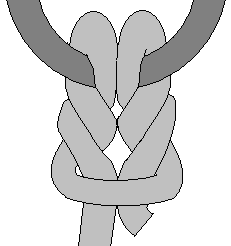(Marked this version for translation) |
m (Move brackets to make translation of content possible) |
||
| Line 1: | Line 1: | ||
| − | <noinclude><translate> | + | <noinclude><translate></noinclude> |
| − | </noinclude> | + | |
| − | {{Knot | + | {{ |
| + | Knot | ||
| name=Cat's paw | | name=Cat's paw | ||
| image= catspawknot.png | | image= catspawknot.png | ||
| Line 18: | Line 19: | ||
<!--T:3--> | <!--T:3--> | ||
When using the cat's paw to join two eyes, this process may be repeated several times to give several turns - as many as five in a fine fishing monofilament. Then when tightened, instead of pulling the bight up against the turns, both eyes are pulled equally, to make neat coils of turns in both eyes, meeting halfway between them. | When using the cat's paw to join two eyes, this process may be repeated several times to give several turns - as many as five in a fine fishing monofilament. Then when tightened, instead of pulling the bight up against the turns, both eyes are pulled equally, to make neat coils of turns in both eyes, meeting halfway between them. | ||
| + | |||
}} | }} | ||
| + | |||
<noinclude></translate></noinclude> | <noinclude></translate></noinclude> | ||
| − | |||
Revision as of 14:21, 9 November 2018
| Cat's paw |
|---|
|
Use: The Cat's paw is used for connecting a rope to an object.
How to tie:
Form a bight in the middle of the line, and pull it back over itself like a girth hitch. This forms two loops, turned in opposite directions. Give each loop one more full turn in the direction that will tend to tighten it (the wrong direction will undo the loop completely). Pass both loops over the hook, rail or post and pull tight, taking care to push the bight up snugly against the turns.
If working end of the line has an eye in it, and the standing end is accessible, the knot can be tied to a closed ring, another eye, or a rail with inaccessible ends, as follows. Pass the eye around the ring or rail, then pass the standing end through its own eye (this effectively forms a girth hitch). Then pass the standing end through the eye again, and pull up tight, taking care to push the bight up snugly against the turns. When using the cat's paw to join two eyes, this process may be repeated several times to give several turns - as many as five in a fine fishing monofilament. Then when tightened, instead of pulling the bight up against the turns, both eyes are pulled equally, to make neat coils of turns in both eyes, meeting halfway between them. |

